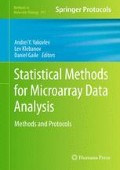Abstract
In this chapter, we discuss a method of selecting differentially expressed genes based on a newly discovered structure termed as the δ-sequence. Together with the nonparametric empirical Bayes methodology, it leads to dramatic gains in terms of the mean numbers of true and false discoveries, and in the stability of the results of testing. Furthermore, its outcomes are entirely free from the log-additive array-specific technical noise. The new paradigm offers considerable scope for future developments in this area of methodological research.
Access this chapter
Tax calculation will be finalised at checkout
Purchases are for personal use only
References
Efron B (2003) Robbins, empirical Bayes and microarrays. Ann Stat 31:366–378
Efron B (2004) Large-scale simultaneous hypothesis testing: the choice of a null hypothesis. J Am Stat Assoc 99:96–104
Efron B, Tibshrani R, Storey JD, Tusher V (2001) Empirical Bayes analysis of a microarray experiment. J Am Stat Assoc 96:1151–1160
Allison DB, Gadbury GL, Heo M, Fern’andez JR, Les C-K, Prolla JA, Weindruch R (2002) A mixture model approach for the analysis of microarray gene expression data. Comput Stat Data Anal 39:1–20
Dalmasso C, Broët P, Moreau T (2005) A simple procedure for estimating the false discovery rate. Bioinformatics 21(5):660–668
Pounds S, Cheng C (2004) Improving false discovery rate estimation. Bioinformatics 20:1737–1745
Pounds S, Morris SW (2003) Estimating the occurrence of false positives and false negatives in microarray studies by approximating and partitioning the empirical distribution of p-values. Bioinformatics 19:1236–1242
Reiner A, Yekutieli D, Benjamini Y (2003) Identifying differentially expressed genes using false discovery rate controlling procedures. Bioinformatics 19:368–375
Storey JD (2002) A direct approach to false discovery rates. J R Stat Soc Ser B 64:479–498
Storey JD, Tibshirani R (2003) Statistical significance for genomewide studies. Proc Natl Acad Sci USA 100(16):9440–9445
Tsai C-A, Hsueh H-M, Chen JJ (2003) Estimation of false discovery rates in multiple testing: application to gene microarray data. Biometrics 59:1071–1081
Qiu X, Klebanov L, Yakovlev A (2005) Correlation between gene expression levels and limitations of the empirical Bayes methodology for finding differentially expressed genes. Stat Appl Genet Mol Biol 4:34
Qiu X, Yakovlev A (2006) Some comments on instability of false discovery rate estimation. J Bioinform Comput Biol 4(5):1057–1068
Storey JD, Taylor JE, Siegmund D (2003) Strong control, conservative point estimation and simultaneous conservative consistency of false discovery rates: a unified approach. J R Stat Soc Ser B 66:187–205
Storey JD, Tibshirani R (2003) Statistical significance for genomewide studies. Proc Natl Acad Sci USA 100:9440–9445
Qiu X, Brooks AI, Klebanov L, Yakovlev A (2005) The effects of normalization on the correlation structure of microarray data. BMC Bioinform 6:120
Klebanov L, Jordan C, Yakovlev A (2006) A new type of stochastic dependence revealed in gene expression data. Stat Appl Genet Mol Biol 5 (Article7)
Almudevar A, Klebanov LB, Qiu X, Salzman P, Yakovlev AY (2006) Utility of correlation measures in analysis of gene expression. NeuroRx 3(3):384–395
Klebanov L, Yakovlev A (2006) Treating expression levels of different genes as a sample in microarray data analysis: is it worth a risk? Stat Appl Genet Mol Biol 5, Article 9
Qiu X, Xiao Y, Gordon A, Yakovlev A (2006) Assessing stability of gene selection in microarray data analysis. BMC Bioinform 7:50
Benjamini Y, Hochberg Y (2000) On the adaptive control of the false discovery rate in multiple testing with independent statistics. J Educ Behav Stat 25(1):60
Yeoh E-J, Ross ME, Shurtleff SA, Williams WK, Patel D, Mahfouz R, Behm FG, Raimondi SC, Relling MV, Patel A, Cheng C, Campana D, Wilkins D, Zhou X, Li J, Liu H, Pui C-H, Evans WE, Naeve C, Wong L, Downing JR (2002) Classification, subtype discovery, and prediction of outcome in pediatric acute lymphoblastic leukemia by gene expression profiling. Cancer Cell 1(2):133–143
Westfall PH, Young S (1993) Resampling-based multiple testing. Wiley, New York, NY
Yang YH, Dudoit S, Luu P, Lin DM, Peng V, Ngai J, Speed TP (2002) Normalization for cdna microarray data: a robust composite method addressing single and multiple slide systematic variation. Nucleic Acids Res 30(4):e15
Bolstad BM, Irizarry RA, Astrand M, Speed TP (2003) A comparison of normalization methods for high density oligonucleotide array data based on variance and bias. Bioinformatics 19:185–193
Gordon A, Glazko G, Qiu X, Yakovlev A (2007) Control of the mean number of false discoveries, Bonferroni, and stability of multiple testing. Ann Appl Stat 1(1):179–190
Acknowledgments
This research is supported by NIH Grant GM079259 (X. Qiu) and by Theodosius Dobzhansky Center for Genome Bioinformatics (L. Klebanov).
Author information
Authors and Affiliations
Corresponding author
Editor information
Editors and Affiliations
Rights and permissions
Copyright information
© 2013 Springer Science+Business Media New York
About this protocol
Cite this protocol
Qiu, X., Klebanov, L. (2013). Gene Selection with the δ-Sequence Method. In: Yakovlev, A., Klebanov, L., Gaile, D. (eds) Statistical Methods for Microarray Data Analysis. Methods in Molecular Biology, vol 972. Humana Press, New York, NY. https://doi.org/10.1007/978-1-60327-337-4_4
Download citation
DOI: https://doi.org/10.1007/978-1-60327-337-4_4
Published:
Publisher Name: Humana Press, New York, NY
Print ISBN: 978-1-60327-336-7
Online ISBN: 978-1-60327-337-4
eBook Packages: Springer Protocols

